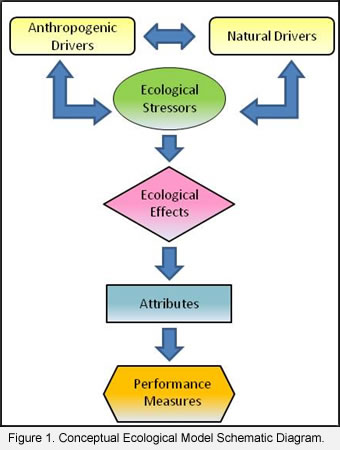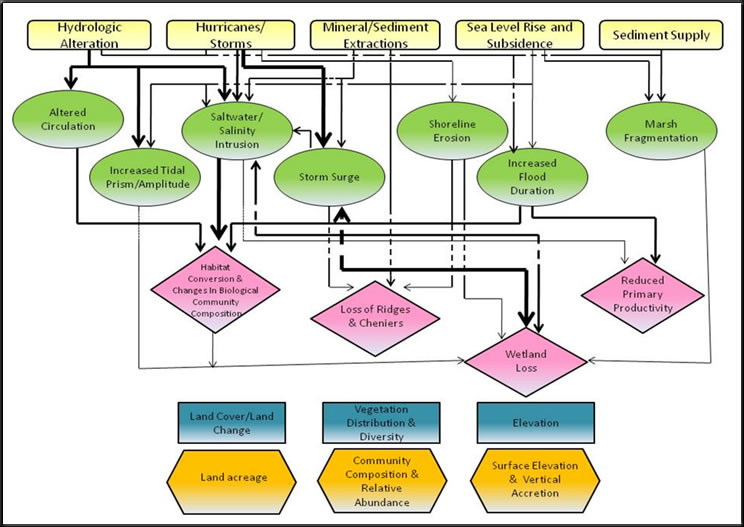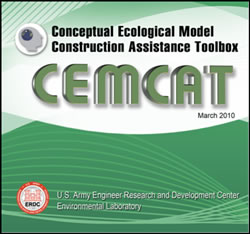Why are Conceptual Models Needed?
A CEM serves as a logical starting point in the planning process for any ecosystem restoration project, and provides support throughout the process.
Conceptual models help to:

- Illustrate important system processes
- Identify attributes and cause-effect relationships
- Synthesize current understanding of system functions
- Isolate and help diagnose significant environmental challenges
- Foster a common understanding of how a system works, what led to the degradation, and how proposed restoration actions address the problems
- Provide insight into potential outcomes of restoration actions within the project area
The CEM development process facilitates communication among scientists, engineers, project managers, and the public; therefore, the process can be as valuable as the product. For these reasons and others, development of CEMs has been recommended for all ecosystem restoration projects (USACE 2008).
Building a Conceptual Model
The model building and development processes consist of determining system parts, identifying relationships that link those parts, specifying the mechanisms of system interaction, and exploring model behavior. Click here to see the 7 Steps.
Developing a conceptual model affords the restoration planning team an opportunity to investigate their understanding of the ecosystem and associated stressors, drivers, issues, and potential restoration options. For this reason, the model is best developed by a team rather than an individual, and iteration is both desirable and typically needed.
A Conceptual Model for Southwest Coastal Louisiana
A draft model was developed by the project delivery team (PDT), stakeholders and invited scientists and resource specialists in a workshop environment. First, facilitators outlined the workshop objectives and described the process and intended product. Then approximately 30 participants expressed their opinions regarding the key model components. Facilitators organized the components into a rough model using a Beta version of the CEMCAT (Conceptual Ecological Model Construction Assistance Toolbox) and displayed the information on a projection screen. Attendees discussed relationships among the model components while facilitators took notes and represented relationships graphically. After approximately six hours, a rough draft model had been prepared and the meeting adjourned.

Figure 2. Southwest Coastal Louisiana Conceptual Model
Following the meeting, two Corps scientists compiled the notes in the form of a narrative to accompany the model diagram. They augmented the narrative with additional information and literature citations, and prepared a draft document. The authors also revised the figure developed during the workshop to better represent model components and linkages. This was accomplished using Microsoft PowerPoint; the current version of CEMCAT could be used to more easily accomplish the revisions. The draft was circulated to the PDT for review and comment, and then revised by the authors. A TN presenting the completed model is available Fischenich and Barnes (2011).
Required Resources
Preparation for the workshop involved less than one man-week of effort by technical specialists and the Project Manager. As discussed, the workshop lasted six hours and involved roughly 30 individuals, and those outside the Corps were self-funded. Development of the model narrative and revisions to the model, including addressing comments from the PDT required approximately two man-weeks of effort from a couple senior scientists. Collectively, the preparation and review of the model required about $25 - $30k, not counting the contributions from non-Corps individuals participating in the workshop or providing review comments.
Helpful Hints for Your Conceptual Model
- Workshop environments are most beneficial.
Interaction among resource specialists is very important to the development of a useful CEM and to the establishment of a shared vision among the Corps and stakeholders; therefore a workshop environment is recommended in the early stages of model preparation.
- Use a facilitator who is familiar with the project.
Facilitators familiar with the project and the ecosystem significantly improves the workshop flow and the product quality.

- Utilize CEMCAT to provide a visual of the conceptual model as it is developed.
The CEMCAT model has evolved considerably in scope and functionality since the workshop for the SW Coastal project. Model enhancements make this tool very useful for guiding the development process and as a tool to compile information and graphically represent the CEM. Click here to access CEMCAT.
- Develop a generic model before the workshop.
The development of a generic model(s) ahead of time that can be viewed by participants and serve as a starting point for discussions might simplify the process.
- Develop more than one model to address various scales or audiences of the project.
Components of a CEM can often be regarded as appropriate at several levels depending upon the scale of analysis and the interdependencies among components. In other words, a component might be either a stressor or a driver, an ecological effect or a stressor, etc., depending on how it is viewed. Allowing discussion regarding these issues is often important and useful, but the process inevitably requires defining the model scale and the component characteristics. Developing more than one model (i.e. nested models) that reflects differing scales can be a useful way of tackling these issues. Multiple models (even at the same scale) might also be required in order to address differing audiences.
This example is by no means the only way of representing ecosystems. In fact, several other models have been constructed describing important processes or sub-systems for the Chenier Plain in Louisiana. Examples of alternative depictions can be found at:
http://www.clear.lsu.edu/conceptual_ecological_models/
EBA Resources


